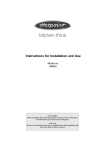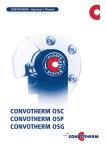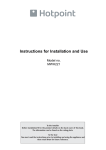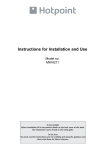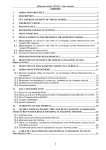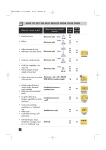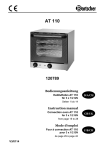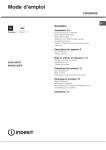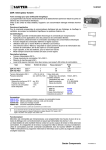Download Hotpoint MWHZ33 User's Manual
Transcript
GB-5719133500
13-07-2004
11:03
Pagina 1
Instructions for Installation and Use
Model no.
MWHZ33
GB-5719133500
13-07-2004
11:03
Pagina 2
Data and instruction for Performance Tests according to IEC 60705 and EN 60705 (1999-04)
The International Electrotechnical Commission SC 59H, has developed a Standard for comparative testing of
heating performances of microwave ovens.
We recommend the following for this oven:
Test Nr. on
standard
Item
Duration
Function
Power
Level
Oven
temp.
Weight
Standing
time
Note
12.3.1
Egg
custard
16 min.
only mw
1000 W
-
750 gr
5 min
The upper surface shall be evaluated after the standing
time. The inner custard evaluation shall be conducted
after two hours.
12.3.2
Sponge
cake
6 min.
only mw
1000 W
-
475 gr
5 min
Use the borosilicate glass container stated in the
Standard (max. dia. 210 mm) or a Pyrex® glass
container dia. 210 mm, height 50 mm and wall thick 6
mm. Put the container on the low wire rack placed on
the turntable.
12.3.3
Meat loaf
20 min.
only mw
750 W
-
900 gr
5 min
Cover the container with cling film and pierce the film.
Use the rectangular borosilicate glass container stated
in the Standard or the Arcopal® Cat. nr. Z1/B8
(01)10460-1.
13.3
Defrosting
minced
meat
11 min.
only mw
-
500 gr
15 min
Place the frozen load directly on the turntable (I ). Turn
the load upsidedown after half of the defrosting time.
12.3.4
Potato
gratin
20 min.
combi
mw + fan
(simult.)
5 min
Use the borosilicate glass container stated in the
Standard (max. dia. 210 mm) or a Pyrex® glass
container dia. 210 mm, height 50 mm and wall thick 6
mm. Put the container on the lower wire rack (F) placed
on the turntable.Do not preheat the oven.
5 min
Use the borosilicate glass container stated in the
Standard (max dia. 210 mm) or a Pyrex® glass
container dia. 210 mm, height 50 mm and wall thick 6
mm. The oven shall be preheated (in FAN ONLY
function) with the lower rack (F) placed on the turntable.
Once preheated, place the container on the lower rack
(F).
5 min
The following instruction shall be strictly observed for
this type of load: put the chicken in a pyrex® glass
container dia 210 mm, height 50 mm and wall
thickness of 6 mm. Put the container on the lower wire
rack (F) placed on the turntable.
12.3.5
12.3.6
2
Cake
Chicken
30 min.
combi
mw + fan
(simult.)
40 min.
combi
mw + fan
(simult.)
750 W
150 W
750 W
190°C
160°C
190°C
1100 gr
710 gr
1200 gr
GB-5719133500
13-07-2004
11:03
Pagina 3
CONTENTS
CHAP. 1 – GENERAL
1.1
1.2
1.3
1.4
1.5
1.6
1.7
1.8
1.9
Description...........................................................page
Description of the control pannel ...........................page
Building-in ...........................................................page
Important safety warnings .....................................page
Technical data ......................................................page
Installation and Electrical Connection .....................page
Accessories supplied.............................................page
Ovenware to use ..................................................page
General rules / suggestions for using the oven .......page
CHAP. 2 – USING THE CONTROLS AND SETTING THE MODES
2.1 Setting the clock ...................................................page
2.2 Programming the cooking .....................................page
2.3 Automatic sequence for defrosting and cooking......page
2.4 Recalling the pre-memorised recipes
(“Automatic Functions” keys) .................................page
2.5 Quick Reheat .......................................................page
2.6 Child lock-out feature............................................page
2.7 Turntable stop key.................................................page
2.8 Function “Memotime” ...........................................page
4
5
6
9
10
10
11
12
13
14
15
17
18
18
18
18
18
CHAP. 3 – USING THE PASTA FUNCTION
3.1 Introduction..........................................................page 20
3.2 Using the cooker and setting the controls ...............page 20
3.3 Important warnings ..............................................page 23
CHAP. 4 – USING THE OVEN:
4.1
4.2
4.3
4.4
4.5
4.6
4.7
4.8
SUGGESTIONS AND COOK CHARTS
Defrosting ............................................................page
Reheating ............................................................page
Cooking starters, pasta and entrees .......................page
Cooking meat .....................................................page
Cooking side dishes and vegetables ......................page
Cooking fish.........................................................page
Cooking desserts and cakes .................................page
Reheating/cooking using the
“Automatic Functions” keys ...................................page
4.9 Simultaneous cooking on 2 levels ..........................page
24
25
26
26
27
28
28
29
30
CHAP. 4 – CLEANING AND MAINTENANCE
4.1 Cleaning..............................................................page 32
4.2 Maintenance ........................................................page 33
3
GB-5719133500
13-07-2004
11:03
Pagina 4
CHAPTER 1 – GENERAL
1.1 DESCRIPTION
A
C
F
G
H
I
B
D
T
E
A
B
C
D
E
F
Grill heating element
Control panel
Microwave outlet cover
Turntable spindle
Inside of door
Low wire rack
G
H
I
L
High wire rack
Turntable
Turntable support
Rectangular grill
Spacer wire rack at medium height level that makes it possible to cook, defrost and reheat
with microwave only function, two food dishes at the same time (simultaneous insertion of
two plates or pans). Consult the instructions given on page 55.
PASTA COOKER
Hatch cover
Cooker
support
Handle
Mixer
Handle
Pasta container
Shaft
4
GB-5719133500
13-07-2004
11:03
Pagina 5
1.2 DESCRIPTION OF THE CONTROL PANEL
1
2
3
5
4
7
9
10
11
12
13
6
15
8
14
Time and mode display
Oven temperature display
FUNCTION key: mode selection
key: oven temperature selection
POWER LEVEL key: microwave power level
selection
6.
key: setting the clock
7 - 8 - 9 “Automatic Functions” keys:
pre-memorised rapid cooking
10 - 11 “Pasta“ buttons
1.
2.
3.
4.
5.
STOP key: interruption of cooking and
cancellation of settings
13.
START key: start of cooking and rapid
reheating
14.
knob: setting of time and length of cooking
15. Turntable stop key
12.
5
GB-5719133500
13-07-2004
11:03
Pagina 6
1.3 BUILDING-IN
AInside the oven there is a plastic bag with fixing material. Take this bag out of the oven.
1. Remove the two screws (X) from the fastening bar under the microwave oven.
2. Fasten metal strip (A) using the two screws (X) that have just been removed.
55
0m
in.
50
min
.
8
0+ 0
56
450+2
0
A
29
5m
in.
30
=
=
850 min
30
18
X
458
X
The appliance needs sufficient ventilation. Make an opening in
the plinth at least 280 cm2 large for this purpose.
6
5
59
GB-5719133500
13-07-2004
11:03
Pagina 7
3. Fit the fastening bar (B) at the correct position in the recess. Make sure that there is the same amount of
free space at each side of the fastening bar. Fasten the bar with the screws (H).
H
B
B
H
=
=
B
H
Fix the fastening bar such that the two lips stick out over the edge of the bottom of the recess and rest against it
at the front.
7
GB-5719133500
13-07-2004
11:03
Pagina 8
4. Open the lid of the smoke discharge (C) fully.
5. Slide the appliance into the recess. Slide the front of the appliance over the fastening bar (B). Keep sliding it
until the front of the oven (G) is resting against the cupboard and the holes (D) under the oven are aligned
with the holes (E) in the fastening bar (B).
6. Fasten the appliance to the fastening bar (B) using the screws (F).
G
B
C
E
F
B
D
G
D
Important: After the installation has been performed, the power supply cable and the power socket must be easy
to access.
8
GB-5719133500
13-07-2004
11:03
Pagina 9
1.4 FOR YOUR SAFETY
Read these instructions carefully and keep for future reference.
N.B. This oven has been designed to defrost, heat and cook food in the home. It must never be used for other
purposes, modified or tampered with in any way.
1)
2)
3)
4)
5)
6)
7)
8)
9)
10)
11)
12)
13)
14)
15)
16)
WARNING: If the door or door seals are damaged, the oven must not be operated until it has been
repaired by a competent person (trained by the manufacturer or by its Customer Service).
WARNING: It is hazardous for anyone other than a competent person to carry out any service or repair
operation which involves the removal of a cover which gives protection against exposure to microwave
energy.
WARNING: Liquids and other foods must not be heated in sealed containers since they are liable to
explode. Eggs in their shell and whole hard-boiled eggs should not be heated in microwave ovens since
they may explode even after microwave heating has ended.
WARNING: Children should not be allowed to play with the appliance or tamper with its controls. Do not
allow children near the oven when it is in operation, as this may result in severe burns.
Do not attempt to operate the oven with the door open by tampering with the safety
devices.
Do not operate the oven if objects for any kind get stuck between the front panel of the
oven and the door. Always keep the inside of the door (E) clean, using a damp cloth
and non-abrasive detergents. Do not allow dirt or remains of food to accumulate
between the front panel of the oven on the door.
The following warnings must be observed when the door is open: Do not place heavy
objects on the door or pull the handle downwards any further. Never place hot containers or pans (e.g. just taken off the stove) on the door.
If the power cable becomes damaged, this must be substituted only by specialised personnel authorised or by the manufacturer.
If smoke is observed, switch off or unplug the appliance and KEEP THE DOOR
CLOSED in order to stifle any flames.
Only use utensils that are suitable for use in microwave ovens. In order to avoid overheating and the consequent risk of fire, it is advisable to supervise the oven when
cooking food in disposable containers made of plastic, cardboard or other inflammable materials, and when heating small quantities of food.
Never place the turntable in water after it has ben heated for a long time. The high
thermal shock resulting would break the turntable.
You must not either preheat or operate the microwave oven in any way without food
in the oven. Sparking can occur if you were to ignore this warning.
Before using this oven, make sure that the utensil and containers chosen are suitable
for microwave oven use (see the section on "Glassware and Similar Items").
When heating liquids (water, coffee, milk, etc.) it is possible that the contents may suddenly start to boil and spill violently as a result of delayed boiling, causing scalding.
To avoid this happening, you should place a heat-resistant plastic spoon or a glass rod
in the container before starting to heat liquids. Anyway, care should be taken when
handling the container.
Do not heat spirit with a high alcohol content, nor large quantities of oil, as these could
catch fire !
The contents of feeding bottles and baby food jars should be stirred or shaken and the
temperature should be checked before consumption in order to avoid burns. It is also
advisable to stir or shake the food in order to ensure that it has an even temperature.
When using commercially available bottle sterilisers, before turning the oven on,
ALWAYS make sure the container is filled with the quantity of water indicated by the
manufacturer.
When the oven is used for the first time it is possible that, for a period of approx.
10 minutes, it may produce a “new” smell and a small amount of smoke. This is
only a result of protective substances applied to the heating element.
9
GB-5719133500
13-07-2004
11:03
Pagina 10
1.5 TECHNICAL DATA
ENERGY CONSUMPTION ventilated oven only function (CENELEC HD 376 norms)
To reach 200°C
0,35 kWh
To maintain a temperature of 200°C for an hour
1,15 kWh
Total consumption
1,5 kWh
• OUTPUT POWER - MICROWAVE: 1000 W (IEC705)
For additional data, consult the data plate placed on the front side of the appliance.
This appliance complies to E.E.C. directive no. 89/336 and 92/31 regarding Electromagnetic
Compatibility, and to directive 89/109/E.E.C. regarding materials which come into contact with food.
OUTPUT POWER
The microwave output power is written on the rating plate placed on the control panel (see “MICRO OUTPUT”). When
you consult the tables, always look up your oven’s output power. It will be useful also when you are consulting cookbooks intended for use with microwave ovens.
ONLY FOR SOME MODELS: The microwave output power is also indicated inside this
simbol, placed on the door.
(ONLY FOR U.K.) The letter indicates the heating category to which your oven
belongs: some pre-cooked food packages (frozen or chilled) give heating instructions
corresponding to the various categories. Follow those instructions related to the category indicated for your oven.
1.6 INSTALLATION AND ELECTRICAL CONNECTION
1)
2)
3)
4)
5)
6)
7)
8)
Remove all the accessories and wash them.
Clean the inside with a soft, damp cloth.
Check that there is no damage as a result of transportation, and in particular that the door opens and closes properly.
Place the support (I) in the centre of the circular groove and fix the turntable (H) to it. The spindle (D) should
be inserted in the corresponding groove in the centre of the turntable.
After the installation has been performed, the power supply cable and the power socket must be easy to
access.
Only a qualified electrician may install or relocate a socket outlet.
Only connect the appliance to a power socket with a power capacity of at least 16A. Also make sure that the
main switch installed in your home has a minimum power capacity of 16A in order to avoid it suddenly tripping while the oven is on.
Before use, check that the power supply voltage is the same as the one shown on the rating label and that
the power outlet is properly earthed: the manufacturer disclaims any liability in the event of non-compliance
with this safety regulation.
ELECTRICAL CONNECTION (U.K. ONLY)
A)
If your appliance comes fitted with a plug, it will incorporate a 13
Amp fuse. If it does not fit your socket, the plug should be cut off from
the mains lead, and an appropriate plug fitted, as below.
WARNING: Very carefully dispose of the cut off plug after removing
the fuse: do not insert in a 13 Amp socket elsewhere in the house as
this could cause a shock hazard.
With alternative plugs not incorporating a fuse, the circuit must be
protected by a 15 Amp fuse.
WARNING - THIS APPLIANCE MUST BE EARTHED
IMPORTANT
The wires in the mains lead are coloured in accordance with the following
code:
Green and yellow:
Earth
Blue:
Neutral
Brown:
Live
10
B)
If the plug is a moulded-on type, the fuse cover must be re-fitted when
changing the fuse using a 13 Amp Asta approved fuse to BS 1362.
In the event of losing the fuse cover, the plug must NOT be used until
a replacement fuse cover can be obtained from your nearest
electrical dealer. The colour of the correct replacement fuse cover is
that as marked on the base of the plug.
If your appliance is not fitted with a plug, please follow the
instructions provided below:
As the colours of the wires in the mains lead may not correspond with the
coloured markings identifying the terminals in your plug, proceed as
follows:
The green and yellow wire must be connected to the terminal in the plug
marked with the letter E or the earth symbol
or coloured green or
green and yellow.
The blue wire must be connected to the terminal marked with the letter N
or coloured black.
The brown wire must be connected to the terminal marked with the letter L
or coloured red.
GB-5719133500
13-07-2004
11:03
Pagina 11
1.7 ACCESSORIES SUPPLIED
LOW WIRE RACK
Fan Oven Only mode:
for all types of traditional cooking,
especially cakes.
Combined microwave and fan
oven mode and microwave + grill:
for rapid cooking of meat, potatoes, some leavened cakes and
desserts and gratinéed dishes (for
example, baked lasagne).
HIGH WIRE RACK
Grill Only mode:
for all types of grilled food.
TURNTABLE and TURNTABLE SUPPORT
The turntable and its support are
used for all the modes, except for
the pasta mode.
RECTANGULAR RACK
Only for ventilated oven:
For all types of traditional cooking
in large sized rectangular casserole
dishes. Naturally, the food must be
stirred and turned during the cooking process. Position this rack
directly on the bottom of the oven.
The rotating plate (H) can be left in
place. This rack cannot be used for
microwave cooking.
MEDIUM WIRE RACK
Microwave-only function:
For all types of cooking on two
levels AT THE SAME TIME
(e.g., large amounts of food or
different foods).
See the instructions on page 30
PASTA COOKER and COOKER SUPPORT
Support to be used with pasta cooker only.
Note: The round metal racks supplied are protected by a special chrome plating which allows them to be used
safely in your microwave.
11
GB-5719133500
13-07-2004
11:03
Pagina 12
1.8 OVENWARE TO USE
In the “Microwave Only” and “Microwave Combined” modes, all types of containers in glass (preferably Pyrex),
ceramics, china and clay may be used provided that they are undecorated and free of metal parts (i.e. gilt trimmings, handles, feet etc.). Heat resistant plastic containers can also be used, but only for “Microwave Only”
cooking. If you are still doubtful about using a particular container, you can perform a simple test. Place the
empty container in the oven for 30 seconds at maximum power (“Microwave Only” function).
If the container is still cold or only slightly warm, it is suitable for microwave cooking.
If it is very hot or gives out sparks, it is not suitable.
Paper napkins, cardboard trays and disposable plastic plates can also be used for short cooking times. The size
and shape of the containers must be such as to allow them to rotate properly inside the oven.
Metal, wood, cane and crystal containers are not suitable for microwave cooking.
It is worth remembering that - since microwaves heat the food, not the dish - it is possible to cook the food directly on the plate on which it is to be served. This means that you do not need to use, and wash up, saucepans.
However, remember that heat may be transferred from the food itself to the plate, making it necessary to use an
oven glove.
If the oven has the “Fan Oven Only” or “Grill only” settings, all types of ovenware may be used.
In any case, observe the guidelines shown in the following table:
Glass
Pyrex
Glassceramics
Clay
Silver foil
Plastic
Paper or
cardboard
Metal
containers
Mode:
“Microwave Only”
YES
YES
YES
YES
NO
YES
YES
NO
Modes:
“Combined”
NO
YES
YES
YES
NO
NO
NO
NO
Mode:
“Fan Only”
“Grill Only”
NO
YES
YES
YES
YES
NO
NO
YES
Important: Do not use this accessory with the "Grill Only", "Fan Only", "Combi
Fan" or "Combi Grill" mode as the high temperatures could cause damage.
12
GB-5719133500
13-07-2004
11:03
Pagina 13
1.9 GENERAL RULES FOR MICROWAVE COOKING
Microwaves consist of electromagnetic radiation found in nature under the form of light waves (e.g., sunlight). Inside
the oven, these waves penetrate food from all directions and heat up the water, fatty and sugar molecules.
Heat is produced very quickly only in the food itself, whereas the container being used warms up indirectly by
means of heat given off by the heated food. This prevents food from sticking to its container, so you can use very
little fatty substance or, in some cases, no fat at all during the cooking process.
Therefore cooking in a microwave oven is considered to be healthy and good for one’s diet. And in contrast to
traditional methods, cooking in a microwave foodstuffs are less dehydrated, lose less of their nutritional value,
and retain more of their original flavour.
Basic rules for correct cooking with a microwave oven
1) In order to set cooking times correctly, remember (in referring to the charts on the following pages) that when you increase the amount of foodstuffs the cooking temperature must likewise be proportionately increased and vice-versa. It is important to
respect the “standing” times: standing time means that period during which the food
must be left to “rest” after being cooked so as to allow an even greater spreading of
the temperature within. The temperature of meat, for example, will rise about 5°-8°
C. (approx. 9°-15° F.) during the standing time. Standing times may be observed
either inside or outside the oven.
2) One of the main things you must do is stir the food several times while it is being
cooked. This helps make the temperature distribution more uniform and thus shortens the cooking time.
3) It is also advisable to turn the foodstuff over during its cooking process: this applies
especially for meat, whether it is in large pieces (roasts, whole chickens, etc.) or small
(chicken breasts, etc.).
4) Foods having a skin, shell or peel (e.g., apples, potatoes, tomatoes, frankfurters,
fish) must be pierced with a fork in several points so as to permit steam to escape
and to prevent those items from exploding.
5) If you are preparing a large number of portions of the same food item (e.g., boiled
potatoes), place those portions in a Pyrex dish in order to have them cook in a uniform manner.
6) The lower the temperature at which a foodstuff is placed in a microwave oven, the
longer the cooking time required. Food having a room temperature will cook more
quickly than food having a refrigerator temperature.
7) Always do your cooking by placing the food container in the centre of the turntable.
8) It is perfectly normal for condensation to form inside the oven and near the air outlet. To reduce such condensation, cover the foodstuffs with clear-sheet, wax paper,
a glass lid or simply an overturned plate. Foods having a water content (e.g.,
greens and vegetables) cook better when covered. The covering of food also helps
keep the oven clean on the inside. Use clear-sheet made expressly for microwave
ovens.
9) Do not cook eggs in their shells: the pressure which builds up on the inside would
cause the egg to explode, even after cooking has finished. Do not heat up eggs which
have already been cooked, unless they are scrambled.
10) Do not forget to open containers which are air-tight or sealed, before heating or
cooking food in the oven. The pressure on the inside of the container would rise,
causing them to explode even after cooking has finished.
13
GB-5719133500
13-07-2004
11:03
Pagina 14
CHAPTER 2 – USING THE CONTROLS AND MODES
2.1 SETTING THE CLOCK (for key references see page 5)
•
When the appliance is connected to the domestic power supply for the first time, or after a power cut, four
dashes will appear on the display (----).
In order to set the clock, proceed as described below:
1
Press the
key (6).
(The hours flash on display 1)
2
Set the desired time by turning the
knob (14).
(The hours flash on display 1)
3
Press the
key (6) again.
(The minutes flash on display 1)
4
Set the desired minutes by
turning the
knob (14)
(The minutes flash on display 1)
5
Press the
key (6) again.
(The display shows the time set)
•
•
14
If you wish to change the hour on the dial once it has been set, press the
key (6) before proceeding
to set the new time as described above.
It is possible to display the current time even after starting the mode set, by pressing the
key (6) (the
time is displayed for 2 seconds).
GB-5719133500
13-07-2004
11:03
Pagina 15
2.2 PROGRAMMING THE COOKING (for key references see page 5)
1
INDICATOR
Press the FUNCTION key (3) (mode
selection) and select the desired
mode, which will be shown by the
corresponding indicators coming
on, on display 1. The available
modes are:
MODE SELECTED
INDICATOR
MODE SELECTED
Microwave Only
Combined Microwave and Grill
Automatic Defrosting
Fan Oven Only
Combined Microwave and
Fan Oven
Grill Only
Countdown
2
Set the length of cooking time, in
minutes, by turning the
knob
(14).
In order to choose the length of
cooking time, always refer to the
tables shown in Chapter 3.
3
In the modes:
Microwave Only
Combined Microwave + Fan
Oven
Combined Microwave + Grill
Select the power level of the microwave by repeatedly pressing the POWER LEVEL (5) key, until it begins to flash
the power desired, expressed in numbers (Watt) above the display 2 (on the bottom). In order to select the power,
always refer to the tables shown in Chapter 3.
Note • it is not necessary to select any level of power for the Automatic Defrosting mode.
• in the Combined Microwave + Fan Oven mode the maximum microwave power which can be
selected is 750 Watts.
• it is possible to modify the power set even during cooking, simply by pressing the POWER LEVEL key
(5).
15
GB-5719133500
13-07-2004
11:03
Pagina 16
4
In the modes:
Combined microwave + fan oven
Fan oven only
Select the cooking temperature by repeatedly pressing the
key (4) until display 2 (below) shows the
desired temperature. In order to select the temperature, always refer to the tables shown in Chapter 3.
Note • once the cooking has started, display 2 will show the increase in real temperature inside the oven.
• once the temperature set has been reached, a signal will be emitted (3 beeps). The temperature set
will then remain shown on display 2.
• it is possible to modify the power set during cooking, simply by pressing the
key (4).
5
Start the cooking process by pressing the START
key (13). The countdown of the remaining cooking time will appear on the display 1, and
if included in the mode, the oven temperature on the display 2.
Note: Should the cooking process for any reason fail to start, all the settings will be automatically cancelled
after 2 minutes.
6
When cooking finishes, a signal is emitted (3 beeps) and the word
“END” will appear on the display. Open the door and take out the food
(the clock will appear, or if the oven is hot, the word “COOL” – see note
below).
Note:
• It is possible to check the progress of the cooking at any time, by opening the door and inspecting the food.
This interrupts the emission of microwaves and the oven stops working until the door is closed again and the
START key (13) is pressed.
• Should it be necessary for any reason to suspend the cooking without opening the door, you only need to
press the
STOP key (12).
• In order to complete the cooking, proceed as follows:
- if the oven door is open, press the
STOP key (12) once;
- if the door is closed and cooking is underway, press the
STOP key (12) twice; the display will go back
to showing the clock.
• this model is equipped with an automatic cooling cycle which comes into action whenever the oven is very
hot (for example after something has been cooked for a long time). During this cycle the word “COOL” will
appear on display 1. The fans and the oven light will come on (they will go off automatically).
While the word “C o o l” is displayed, the oven will accept each commands except the “Pasta” keys.
At the end of each cooking cycle, the oven light and the cooling fan will remain in operation until the oven
door is opened.
16
GB-5719133500
13-07-2004
11:03
Pagina 17
2.3 AUTOMATIC DEFROSTING AND COOKING SEQUENCE (for key references see page 5)
In order to programme an automatic defrosting and cooking sequence proceed as follows:
1
Set the automatic defrosting mode by
pressing the FUNCTION key (3) twice
(mode selection) . The indicator corresponding to the automatic defrosting
will appear on the display.
2
Set the length of time required for
the defrosting (in minutes) by turning the
knob (14).
3
Set the cooking by selecting the
desired mode with the FUNCTION
key (3) (mode selection) until the
corresponding indicators appear.
(ex. Combined microwave + fan function)
4
Adjust the length of cooking time
and, if included in the mode, the
microwave power level and the
oven temperature as shown in the
preceding paragraph (par. 2.2).
5
Press the
START key (13).
The passage from defrosting to cooking will be signalled by a signal.
+
17
GB-5719133500
13-07-2004
11:03
Pagina 18
2.4 RECALLING THE PRE-MEMORISED RECIPES (“AUTOMATIC FUNCTIONS” KEYS) (for key references see page 5)
1
Press the desired “Automatic Functions” key.
(The indicators of the length and temperature set will flash on the display and the pre-memorised mode and power level indicators will come
on.)
Refer to paragraph 4.8 in order to choose the most suitable menu.
2
Press the
3
At the end of the time set 3 long beeps will be heard and the word
“EE N D” will appear on the display.
START key (13) in order to start cooking.
2.5 QUICK REHEAT
This mode is very useful for heating small quantities of food or drink.
•
Press the
START key (13); the oven will come on for 30 seconds at full power. By pressing the
START key again the time will extend by 30 seconds intervals, up to 3 minutes.
•
This mode is activated only if it is carried out within 1 minute after the food has been placed in the oven.
The Quick Reheat is also useful to complete unfinished cooking.
Once the cooking procedure has begun, the programmed time can be modified with the
(14) knob to a maximum time limit of 60 minutes.
2.6 CHILD LOCK-OUT FEATURE
The oven is equipped with a safety device which prevents pre-set cooking times from being tampered with while
the cooking is underway, in order to avoid accidental and dangerous extensions to the cooking time which might
cause the food to burn.
To activate the safety device:
• Keep the
STOP key (12) pressed down for 5 seconds.
• A short beep is emitted: from this point it will no longer be possible to alter the times during all cooking.
• In order to deactivate the safety device once it has been previously activated, keep the
STOP key (12)
pressed until the beep is heard.
2.7 TURNTABLE STOP KEY
When using large sized containers/recipients (or containers with handles) that are not able to rotate, the movement of the turntable can be stopped. Press the
TURNTABLE STOPPER key (15), after having first set a cooking function: the LED in the top right will start flashing.
After having pressed
START, the LED will flash a further 5 times, and will then remain on for the entire set
time; for best results, the food should be mixed/stirred a number of times during cooking. The TURNTABLE STOPPER function will remain on when the oven is used again, that is until the TURNTABLE STOPPER key is pressed
again. For the microwave-only function, the maximum power available is 750W (reduced automatically by the
electronic controller when pressing the TURNTABLE STOPPER key).
2.8 “MEMOTIME” FUNCTION
This function allows for the use of the timer, with the oven NOT functioning, for up to 60 minutes.
• Press the FUNCTION key until 3 dashes appear on display 2, then select the time desired by turning the
(14) knob and start the timer by pressing the
START (13) key.
• At the end, 3 beeps will sound and the “end” warning will appear on display 1.
18
GB-5719133500
13-07-2004
11:03
Pagina 19
CHAPTER 3 - USING THE PASTA COOKER
Pasta cooking using the exclusive accessory Pasta with this oven has been analysed by sensory and chemical
tests at the University of Bologna, Italy, as confirmed by the accompanying certificate:
PRELIMINARY RESULTS OF ONGOING COLLABORATION WITH UNIVERSITY OF BOLOGNA (SITE OF CESENA)
Introduction
Object of the agreement was the comparative evaluation of pasta quality submitted to traditional cooking (in boiling water)
and cooked using the microwave equipment (Patent MI2001A002147).
Description of tested technology
During the experimental study, a microwave (MW) oven, suitable for domestic use, equipped with an originally designed
and patented container, was used to cook spaghetti samples.
The quality parameters of MW cooked pasta have been compared, using strictly standardised procedures, with similar
pasta samples obtained from traditional cooking cycles in boiling water, following the directions suggested by the pasta
producer.
Having thoroughly tested the innovative MW equipment, subjected to critical evaluation in the present study, it was possible to automatically cook pasta just by placing a well defined amount of uncooked dry pasta in the container supplied with
the oven, adding the right quantity of water (tap water or pre-heated water), and starting the oven.
Methodology
Analytical methodologies have been used to evaluate some characteristic aspects of cooked pasta as absolute values through a comparison between MW oven cooked pasta and traditional cooked pasta, following cooking directions generally
used in both domestic and industrial cooking in catering service.
Analytical controls
Analytical evaluations were carried out in laboratory about the behaviour of pasta during cooking (water increase, weight
increase, release of starch ), instrumental test of pasta rheology and quality (superficial stickiness, firmness, colour, volume
increase, etc.), and sensorial evaluation by a trained panel test.
Furthermore, structures of samples from both MW and traditionally cooked pasta were examined by scanning electronic
microscopy (SEM).
Most of the methodologies have been chosen on the basis of national and international literature on pasta quality evaluation.
To perform the comparative study was used the same batch of pasta coming from the largest pasta manufacturer in Italy.
Results
On the basis of the performed research, it has been shown that the two methods of cooking are statistically equivalent for
quality parameters, i.e. water absorption, weight increase, stickiness, firmness, colour and volume increase during cooking.
The rate of release of organic material (mainly starch) from the pasta sample into the cooking water and the rate of gelatinisation of starch in the samples, resulted significantly (p < 0.05) lower for MW cooked samples. These results could mean
a higher level of retention of original starch in the pasta structure.
This could be explained by the temperature profile of the cooking cycle that, in MW cooking, reaches the boiling point of
water only at the end of the cooking time.
Sensorial analysis by panel test showed that the two samples (MW and traditional cooked pasta) are not significantly different taking into account most of the sensory descriptors, such as firmness, superficial stickiness, sauce adhesion, etc.
Judgement on MW pasta cooking apparatus
The obtained results allow to confirm that the use of the innovative MW pasta cooking equipment, by following manufacture directions, is suitable to cook a good quality pasta in a domestic environment.
In witness whereof
Prof. Marco Dalla Rosa
Visiting Professor of Food Technology Processes
Food Sciences and Technologies, University of Bologna.
19
GB-5719133500
13-07-2004
11:03
Pagina 20
3.1 - INTRODUCTION
The pasta cooker accessory can be used to cook all types of pasta, maintaining its nutritional value.
This new and exclusive system reduces cooking time and simplifies preparation, avoiding the need to add the pasta
once the water has come to the boil, mix it during cooking or raise the cover to avoid the foam boiling over.
Before using for the first time, wash all pasta cooker accessories with water and washing up liquid or in a
dishwasher.
3.2 - USING THE COOKER AND SETTING THE CONTROLS
1
I
Remove the turntable (H) and turntable support with wheels (I) from the
oven.
H
2
Position the pasta cooker support as shown in the figure, inserting the three
pins into the three holes in the bottom of the cavity (the word PASTA should
face the front).
3
Insert the shaft into the hole in the bottom of the container. To lock the shaft, push upwards and rotate until
the two teeth protrude from the slots (this can be facilitated by looking from the inside of the container).
Insert the mixer into the central housing, making sure the blades are in contact with the bottom and not
raised excessively.
4
Add the pasta to the container (max. 400 g), taking care not to
exceed the L2 level on the mixer. Whole spaghetti must be positioned
in the special compartment illustrated in the figure. Make sure the
spaghetti are not raised.
20
GB-5719133500
5
13-07-2004
11:03
Pagina 21
Level the pasta by shaking the container gently. Pour in the water (*) required to cover the pasta completely until it reaches one of the two levels (L1 or L2) on the mixer as shown in the pictures below:
RIGHT:
L2
L1
The pasta is completely covered by the water at the L1 level (min).
L2
L1
The pasta is completely covered by the water at the L2 level (max).
WRONG:
L2
L1
L2
L1
L2
L1
The pasta is not properly covered by the water.
Water level is between L1 and L2
(it must be either L1 or L2 level)
The level of water exceeds the maximum amount of water allowed for the
PASTA function (over the L2 level)
Remember that the level of water must ALWAYS reach either Level L1 or Level L2 and must never be between the two.
IMPORTANT:
• REMEMBER TO PUT IN THE PASTA FIRST AND THEN THE WATER.
• THE PASTA MUST BE COMPLETELY COVERED BY THE WATER OR PASTA EMERGING
FROM THE WATER COULD BE OVERCOOKED AND ASSUME A BURNT COLOUR.
Remember that pasta increases considerably in volume during cooking. If level 1 provides only minimal coverage of the pasta (eg. pasta with high volume formats), you are recommended to increase the water to L2.
(*)
The water may be either at room temperature (about 20°C) or hot (about 50°C).
The hotter the water, the shorter the cooking time.
21
GB-5719133500
6
13-07-2004
11:03
Pagina 22
Add salt (10 g. salt for each liter of water) and cover the container with the cover. Make sure the hatch is
free to open. Place inside the oven, making sure the handles are facing the door as shown in the figure.
The container must be positioned on the pasta cooker mount inserted previously (see point 2); the word
PASTA will appear on the display. Close the door.
about 50°C
about 20°C
7
Select the key corresponding to the
water temperature - red if the
water you have added is hot
(about 50°C) or blue for water at
room temperature (about 20°C).
Set the level of water in the container (L1 or L2) by pressing the
same key a number of times.
The lower display will show the corresponding key selected (hot water or
cold water)
8
22
Select the cooking time written on
the pack for the pasta used (eg. 8
minutes) by rotating the
knob (14).
L2
L1
GB-5719133500
13-07-2004
11:03
Pagina 23
9
Press the
start cooking.
START key (13) to
The oven will automatically calculate the TOTAL time required to heat the water and complete cooking. This will
be immediately displayed.
At the start of cooking, the mixer is stationary. It begins rotating automatically
about halfway through cooking.
One minute from the end, the oven will emit a "beep". This indicates that the time
is nearly over and you are recommended to remove the container and taste the
pasta (through door). Pay attention to the escaping steam.
If the pasta is already cooked, press the
STOP key (12) to interrupt the
remaining cooking programme. If the pasta is still hard, finish cooking for the
remaining minute by pressing the
START key (13).
At the end of the minute, the oven will emit three beeps and the word "End" will
be displayed. You can then remove the container to drain the pasta or check
whether it is cooked again:
If the pasta is already cooked, press the
STOP key (12), drain the pasta keeping the handles firmly pressed
and sloping the container forwards and leftwards to allow the water to drain out of the holes on the left side of
the cover (see figure alongside). Remove the cover, lifting it by the handles (take care to avoid escaping steam),
remove the mixer, pour out the pasta and add the sauce. If the pasta is still not cooked to your taste, the cooking
time can be prolonged by replacing the container, closing the door ("0 00" will flash on the display) and setting
additional minutes by rotating the
knob (14) and pressing the
START key (13).
3.3 - IMPORTANT WARNINGS
When using the pasta cooker accessory, pay attention to the following:
• Take care when removing the container from the oven and draining the pasta. the plastic may seem cold, but
escaping steam could cause burns. You are recommended to use oven gloves.
• Never place the accessory above sources of heat or the oven when in operation.
• Do not cook pasta immediately after using the oven in combi or grill mode. The temperature of the oven could
be too high, thus damaging the container.
While the word “C o o l” is displayed, the oven will accept each commands except the “Pasta” keys.
• Make sure the hatch in the cover is always clean and free to open.
• The pasta cooker must be used to cook pasta according to the instructions in this book. It must never be used
for other purposes.
• Never use the pasta cooker empty without water and pasta.
• While the pasta cooker is in the oven, other modes cannot be set.
To clean the accessory, see page 57.
23
GB-5719133500
13-07-2004
11:03
Pagina 24
CHAPTER 4 – USING THE OVEN: SUGGESTIONS AND COOK CHARTS
4.1 DEFROSTING
• Frozen food in plastic bags, plastic film or cardboard packets can be placed directly in the oven for defrosting as
long as the packet has no metal parts (e.g. metal twist ties or staples).
• Certain foods, such as vegetables and fish, do not require complete defrosting before cooking.
• Boiled foods, stews and meat sauces defrost better and more quickly if they are stirred from time to time, turned over
and/or separated.
• Meat, fish and fruit lose a certain amount of liquid during defrosting. Defrost these foods in a bowl.
• It is advisable to separate each individual piece of meat into its own bag before putting it into the freezer. This will
enable you to save precious preparation time.
• It is important to observe the standing times immediately after defrosting, before cooking; the standing time (in minutes) is the length of time for which the food must be left to stand to allow the heat to continue spreading evenly in
the food.
TABLE OF DEFROSTING TIMES IN “AUTOMATIC DEFROSTING” MODE
TYPE
QUANTITY
TIME (minutes)
• Hamburgers
• Sausages
1 kg
200 gr
500 gr
250 gr
500 gr
200 gr
300 gr
19 - 21
4-6
10 - 12
5-7
10 - 12
5-7
6-8
POULTRY
• Duck, turkey
• Whole chicken
• Pieces of chicken
• Chicken breast
1,5 kg
1,5 kg
700 gr
300 gr
25 - 27
25 - 27
13 - 15
8 - 10
MEAT
• Roasts (pork, beef, veal etc.)
• Steaks, chops, rashers
• Stew, goulash
• Minced
WIRE RACK
TO BE USED
STANDING
TIME
None
None
None
None
None
None
None
20
5
10
15
15
10
10
None
None
None
None
20
20
10
10
Turn the fish over halfway through
defrosting
None
None
None
None
7
7
7
7
Remove the silver foil or the metal parts.
Cheese should not be completely defrosted.
Respect the standing time. The cream
should be removed from its container and
placed in a dish.
None
10
None
15
None
5
None
None
None
None
3
3
3
3
None
None
None
10
10
6
NOTES/SUGGESTIONS
Turn over halfway through defrosting
See note
*
Turn the poultry over halfway through
defrosting . When the standing time is over,
wash under warm water to remove any ice.
VEGETABLES
Frozen vegetables do not need to be defrosted before cooking.
FISH
• Fillets
• Slices
• Whole
• Prawns
300 gr
400 gr
500 gr
400 gr
7-9
8 - 10
10 - 12
8 - 10
MILK/DAIRY PRODUCTS
• Butter
250 gr
4-6
• Cheese
250 gr
5-7
• Cream
200 ml
7-9
BREAD
• 2 medium-sized rolls
• 4 medium-sized rolls
• Sliced bread
• Sliced wholemeal bread
150 gr
300 gr
250 gr
250 gr
1-2
2-4
2-4
2-4
FRUIT
• Strawberries, plums, cherries, redcurrants, apricots
• Raspberries
• Blackberries
500 gr
300 gr
250 gr
8 - 10
5-7
3-5
*
Put the bread directly onto the turntable.
Stir 2-3 times
Stir 2-3 times
Stir 2-3 times
These indications are suitable for performing the minced meat defrosting test according to Regulation 60705, Par. 13.3 (see page 2). Turn
over halfway through the set time. Place directly on the turntable.
Further information, including on other performance tests according to Regulation 60705, is given in the table on page 2.
24
GB-5719133500
13-07-2004
11:03
Pagina 25
4.2 REHEATING
Reheating food is one of the modes in which your microwave oven displays all its usefulness and efficiency. Compared to traditional methods, using a microwave obviously saves time and therefore electricity.
• It is advisable to reheat food (especially if it is frozen) to a temperature of at least 70°C (it must be piping hot). This means
the food will not be ready to eat immediately because it is too hot!) but it will be completely sterilised.
• In order to reheat pre-cooked or frozen food, always observe the following rules:
- always remove the food from metal containers
- cover it with transparent film (of the kind suitable for microwave ovens) or grease proof paper so that all the natural flavour
is preserved and the oven will stay cleaner; the food may also be covered with a an upturned plate;
- if possible, stir or turn the food frequently in order to speed up the reheating process and to make it cook more evenly;
- follow the cooking times shown on the packet with considerable caution; remember that, under certain conditions, the
times shown must be increased.
• Frozen food must be defrosted before being reheated. The lower the initial temperature of the food, the longer the reheating time will have to be.
Note: some dishes can also easily be reheated by using the “Automatic Functions” pre-memorised recipes (see table on page
54).
TABLE OF REHEATING TIMES
TYPE
QUANTITY
TIME
minutes
FUNCTION
POWER LEVEL
SOFTENING AND MELTING FOOD
100 gr
• Chocolate/icing
50-70 gr
• Butter
CHILLED FOODS (5/8°C) up to 20/30°C
“
500
1000
4-5
Put in a dish. Mix the icing once.
0’.10”-0’.15” To melt butter, add one minute.
• Yoghurt
• Feeding bottle
“
“
1000
“
0’.15”-0’.20” immediately after heating to make the temperatura uniform. Check the
0’.30”-0’.35” temperature of the contents before use. With milk at room temperature the
125 gr
240 gr
Remove the metal top. Heat the baby’s bottle without the teat and mix it
heating time is lower. To avoid risk of fire when using dried milk please stir
evenly. Please use already sterilized milk.
PRE-COOKED CHILLED FOODS (initial temp. 5/8°C) up to approx. 70°C
• Packet of lasagne or
stuffed pasta
• Packet of meat with rice
and/or vegetables
• Packet of fish and/or vegetables
400 gr
400 gr
“
“
NOTES/SUGGESTIONS
1000
3-5
“
3-5
300 gr
2-4
“
“
400 gr
4-6
• Plate of meat and/or vegetables
“
“
400 gr
4-6
• Plate of pasta, cannelloni or
“
“
lasagne
300 gr
3-5
• Plate of fish and/or rice
“
“
FROZEN FOOD TO BE REHEATED/COOKED (initial temp. -18/-20°C) up to approx. 70°C
• Packet of lasagne or
stuffed pasta
• Packet of meat with rice
and/or vegetables
• Packet of pre-cooked fish
and/or vegetables
400 gr
“
1000
5-7
400 gr
“
“
4-6
300 gr
“
“
2-4
• Packet of fish and/or raw
vegetables
300 gr
“
“
6-8
• Portion of meat and/or vegetables
• Portion of pasta, cannelloni
or lasagne
• Portion of fish and/or rice
400 gr
400 gr
“
“
“
“
5-7
6-8
300 gr
“
“
3-5
Packets of any type of pre-cooked food available in the shops, to
be reheated to 70°C. Remove the food from any metal container
and put it directly onto the plate from which it is to be eaten. For
best results the food should always be covered.
Plate of meat and/or vegetables Portions of any type of cooked
food to be reheated to 70°C. The food should be placed directly
onto the plate from which it is to be eaten and should always be
covered either with transparent film or with an upturned plate.
All kinds of pre-cooked frozen food to be reheated to 70°C
directly in the packet. For metal containers, place the food
directly onto the dish from which it is to be eaten and increase
the cooking time by a few minutes.
Remove raw food from the packets, place it in a container
suitable for microwaves and cover.
Portions of cooked frozen food to be heated to 70°C. Place the
frozen food onto the dish from which it is to be eaten and cover
it with an upturned plate or Pyrex lid. Make sure that it is
thoroughly heated in the centre; if possible, stir the food.
CHILLED DRINKS (5/8°C) up to approx. 70°C
•1
•1
•1
•1
cup of water
cup of milk
cup of coffee
bowl of clear soup
180
150
100
300
cc
cc
cc
cc
•1
•1
•1
•1
cup of water
cup of milk
cup of coffee
bowl of clear soup
180
150
100
300
cc
cc
cc
cc
1000
“
“
“
“
“
“
“
DRINKS AT ROOM TEMPERATURE From 20/30°C up to approx. 70°C
“
“
“
“
1000
“
“
“
1’30” - 2’ All drinks should be shaken after reheating to spread the tempera1’.15” - 1’.45” ture evenly. We recommend covering clear soup with an upturned
1’.15” - 1’.45” plate.
3-4
1’.15” - 1’.45” All drinks should be shaken after reheating to spread the tempera1 - 1’.30” ture evenly. We recommend covering clear soup with an upturned
0’.45” - 1’.15” plate.
2-3
25
GB-5719133500
13-07-2004
11:03
Pagina 26
4.3 - COOKING STARTERS, PASTA AND ENTREES
Vegetable soups and other soups in general require less liquid because in a microwave oven evaporation is rather minimal. Salt must be added only at the end of cooking or during standing time as it dehydrates the food.
It is fair to say that the time needed to cook rice in the microwave oven (as indeed for pasta) is more or less equal to
that needed to cook it on a stove in the traditional manner. The advantage of preparing a risotto in a microwave oven
is that it does not need stirring continually (this only needs to be done 2 or 3 times).
TYPE
• Lasagne
QUANTITY
1100 gr
FUNCTION
+
POWER
LEVEL
TEMPERATURE
TIME
minutes
NOTES/SUGGESTIONS
WIRE RACK
TO USE
1000
-
8
+
Suitable times for uncooked pasta. If the pasta is
pre-cooked, 8 minutes of Combined
MICROGRILL cooking is enough.
Low
1000
Avoid piling them up too heavily
Low
The pasta should have previously been boiled separately.
Low
8
• Gnocchi alla romana
600 gr
1000
-
12
• Macaroni
1500 gr
1000
-
8
• Risotto
• Pizza
300 gr.
of rice
1000
800 gr
-
-
200°C
12-15
30
The ingredients should all be placed together in
a container suitable for microwaves and covered
with transparent film (750 g of clear soup is
needed for 300 g of rice with the microwaves on
full power for approx. 10-12 minutes).
Spread the pizza on oven paper resting on a
shelf for cakes or on the detachable base of
metal baking sheet for cakes. Preheat the oven to
200°C.
None
Low
Use a cake tin with a handle (the oven should be
pre-heated).
• Fresh Quiche Lorraine
800 gr
-
160°C
40
Low
Place on the bottom of a metal baking sheet (the
oven should be pre-heated).
• Frozen Quiche Lorraine
550 gr
-
190°
45
Low
4.4 - COOKING MEAT
Cooking is closely linked to the size and uniformity of the food which is to be cooked: kebabs cook faster then a roast
because they consist of smaller, more evenly-sized pieces of meat. To keep roasts, chicken and kebabs moist, it is advisable to add 1 or 2 cups of water at the start of cooking.
POWER
LEVEL
TEMPERATURE
TIME
minuti
NOTES/SUGGESTIONS
WIRE RACK
TO USE
1000 gr
500
190°C
35-40
Leave on a little fat to avoid it drying out. Do not add
much sauce.
Low
• Meatloaf
800 gr
500
180°C
22-25
Mix 500 g of minced beef with egg, ham, Bread crumbs,
etc. Add a touch of oil and a little white wine.
Low
• Meatloaf
• Whole chicken
• Pieces of chicken
• Kebabs
•Goulash
• Chicken breast
•Veal or pork chop
900 gr
1200 gr
850 gr
600 gr
1500 gr
500 gr
3 pieces
750
750
750
500
1000
700
-
190°C
190°C
180°C
-
20
40
25
17-20
30-35
10-15
16-18
See note
• Sausages
3 pieces
-
-
10-12
Preheat the oven for 3 minutes. Turn through cooking, as the heating element only
irradiates heat from the upper part of the oven.
High
• Hamburgers
3 pieces
-
-
10-12
Preheat the oven for 3 minutes. Turn through cooking, as the heating element only
irradiates heat from the upper part of the oven.
High
TYPE
QUANTITY
•Roasts (pork, beef)
*
**
26
FUNCTION
*
Prick the skin to allow the fat to run off. See note
Stir once during cooking
**
Turn halfway through cooking
Cook uncovered and stir 2-3 times
Turn halfway through cooking
Preheat the oven for 3 minutes. Turn through cooking, as the heating element only
irradiates heat from the upper part of the oven.
None
Low
Low
Low
None
None
High
These indications are suitable for performing the minced meat cooking test according to Regulation 60705, Para. 12.3.3.Cover the container with clear film for microwave use. Further information, including on other performance tests according to Regulation 60705, is
given in the table on page 2.
These indications are suitable for performing the cooking test according to Regulation 60705, Para. 12.3.6. Further information, including on other performance tests according to Regulation 60705, is given in the table on page 2.
GB-5719133500
13-07-2004
11:03
Pagina 27
4.5 - COOKING SIDE DISHES AND VEGETABLES
Vegetables cooked in a microwave oven preserve their colour and nutritional value better than in traditional cooking.
Wash and peel the vegetables before starting to cook.
Larger vegetables should be cut into evenly-sized pieces.
Add approx. 5 spoonfuls of water for every 500g of vegetables (vegetables which have a high fibre content require more water).
The vegetables should always be covered with transparent film.
Stir at least once halfway through cooking and add a little salt only at the end.
Warning: the cooking times in the table are purely intended as guidelines and are on the basis of the food’s weight and initial temperature as well as its texture and structure.
TYPE
QUANTITY
FUNCTION
POWER
LEVEL
TEMPERATURE
TIME
minutes
NOTES/SUGGESTIONS
WIRE RACK
TO USE
Cut into 2 cm pieces
None
It would be better to use artichoke bottoms
None
• Asparagus
500 gr
1000
-
8-9
• Artichokes
300 gr
1000
-
10-11
• Green beans
500 gr
1000
-
10-11 Cut in pieces
• Broccoli
500 gr
1000
-
6-7
Separate into single “florets”
None
• Brussels sprouts
500 gr
1000
-
6-7
Leave whole
None
• White cabbage
500 gr
1000
-
6-7
Leave whole
None
• Red cabbage
500 gr
1000
-
6-7
Leave whole
None
• Carrots
500 gr
1000
-
8-9
Cut into evenly-sized pieces
None
• Cauliflower
500 gr
1000
-
• Cauliflower in béchamel
1000 gr
1000
-
sauce
• Celery
+
10-11 Separate into “florets”
7
None
None
10
Same cooking time as for raw cauliflower. If
pre-cooked, needs only 10 minutes with grill
in Combined mode
6-7
Separate into pieces
None
Cut into cubes
None
Preheat for 3 minutes. Turn halfway through cooking
High
+
Low
500 gr
1000
-
• Aubergines
800 gr
1000
-
5-6
• Grilled aubergines
4 slices
-
-
9-11
• Aubergines “ parmigiana”
1300 gr
1000
-
7-9
The aubergines may be first grilled or fried
•Leeks
500 gr
1000
-
5-6
Leave whole
None
• Button mushrooms
500 gr
1000
-
5-6
Leave whole and cover. No need for water
None
• Onions
250 gr
1000
-
4-5
Whole if even-sized. No need for water
None
• Spinach
300 gr
1000
-
5-6
Cover after washing and draining
None
• Peas
500 gr
1000
-
9-10
• Fennel
500 gr
1000
-
11-12
• Grated tomatoes
800 gr
500
-
9-11
• Peppers
• Grilled peppers
• Stuffed peppers
500 gr
1000
-
8-9
4 quarters
-
-
9-11
1400 gr
+
1000
-
1000
-
8
1000
-
7-8
• Roast potatoes (fresh)
500 gr
500
190°C
25-30
• Courgettes
900 gr
1100 gr
(total)
500 gr
500
200°C
35-40
750
190°C
20
1000
-
It is preferable for them to be even-sized
Cut into pieces
Preheat for 3 minutes. Turn halfway through cooking
Preferably the short, broad kind
None
Low
None
High
Low
9
500 gr
• Potato gratin
None
Cut into quarters
+
• Potatoes
• Roast potatoes (frozen)
Low
6-7
Cut into evenly-sized pieces
Stir 2-3 times
Stir 2-3 times
See note
*
Leave whole
None
Low
Low
Low
None
indications are suitable for performing the cooking test according to Regulation 60705, Para. 12.3.4.
*These
Further information, including on other performance tests according to Regulation 60705, is given in the
table on page 2.
27
GB-5719133500
13-07-2004
11:03
Pagina 28
4.6 - COOKING FISH
Fish cooks very quickly and with excellent results. It can be dressed with a little butter or oil (or even left without). Cover
it with transparent film. Naturally if it has its skin, this must be scored or cut; the fillets should be arranged evenly. It is
not advisable to cook fish breaded with egg.
TYPE
QUANTITY
• Fillets
• Pieces
• Whole
• Whole
• Slices
• Prawns
• Oven cooked
FUNCTION
300 gr
300 gr
500 gr
250 gr
400 gr
500 gr
600 gr
POWER
LEVEL
TEMPERATURE
TIME
minutes
750
750
750
750
750
750
150
190°
5-7
7-9
8-10
5-7
7-9
7-9
30
NOTES/SUGGESTIONS
Cover with film
Cover with film
Cover with film
Cover with film
Cover with film
Cover with film
Add oil, a clove of garlic and drop of white wine and
water. Do not cover.
WIRE RACK TO
BE USED
None
None
None
None
None
None
Low
4.7 - COOKING DESSERTS AND CAKES
For cooking all cakes the oven must be preheated to the temperature shown in the table. Only after reaching the temperature set (signalled by 5 beeps) may the cake by placed in the oven
POWER
LEVEL
TEMPERATURE
1100 gr
150
170°C
25-30 Use a heat-resistant container
Low
• Cheese cake
1500 gr
500
160°C
35-40 Use a heat-resistant container
Low
• Jam tart
700 gr
-
160°C
40
Use a metal cake tin
Low
• Plum cake
950 gr
-
160°C
90
Use a rectangular mould
Low
• Light sponge cake
700 gr
-
160°C
40
Use a metal cake tin
Low
• Walnut cake
650 gr
-
160°C
40
Use a metal cake tin
Low
• Egg custard
750 gr
1000
-
16
See note
• Sponge cake
475 gr
1000
-
6
See note
• Cake
710 gr
150
160°C
30
See note
TYPE
QUANTITY
• Hazelnut cake
*
**
***
28
FUNCTION
TIME
minutes
NOTES/SUGGESTIONS
*
**
***
WIRE RACK TO
BE USED
None
Low
Low
These indications are suitable for performing the cooking tests according to Regulation 60705, Para.
12.3.1. Further information, including on other performance tests according to Regulation 60705, is
given in the table on page 2.
These indications are suitable for performing the cooking tests according to Regulation 60705, Para.
12.3.2. Further information, including on other performance tests according to Regulation 60705, is
given in the table on page 2.
These indications are suitable for performing the cooking tests according to Regulation 60705, Para.
12.3.5. Remember to preheat the oven in fan only mode with the low wire rack in place. Further information, including on other performance tests according to Regulation 60705, is given in the table on
page 2.
GB-5719133500
13-07-2004
11:03
Pagina 29
4.8 - REHEATING/COOKING USING THE “AUTOMATIC FUNCTIONS” KEYS
The “Automatic Functions” keys are 3 different programmes with “pre-memorised” length of cooking time, power
level and oven temperature; they afford excellent results for the dishes described in the following table.
KEY
(7)
• Press once
• Press twice
• Press 3 times
• Press 4 times
WHAT TO DO
• Reheat 1 small coffee cup (50 cc) at room
temperature.
• Reheat 1 coffee cup (125 cc) starting from
room temperature.
• Reheat one large cup (200 cc) starting from
chilled
• Reheat 1 soup dish (300 cc) starting from
chilled
SUGGESTIONS
After reheating the liquid, stir
well to spread the
temperature evenly.
(8)
Warning: at the end of the reheating the food and the Suitable for cooked portions of
containersi may be very hot. Use tweezers or oven gloves.
• Press once
• Reheat 1 portion (250-350 g)
• Press twice
• Reheat 2 portions (450-550 g)
food, stored in the refrigerator on
the plate (the one from which the
food is to be eaten). In the case of
pre-cooked food products, remove
the food from any aluminium
packaging/containers and place it
on an ovenproof plate.
(9)
Warning: at the end of the reheating the food and the
containersi may be very hot. Use tweezers or oven gloves.
• Press once
• Press twice
• Press 3 times
• Reheat 1 frozen pizza (250-500 g)
• Reheat 1 portion (250-350 g)
• Reheat 2 portions (450-550 g)
Place the pizza directly on the
low wire rack.
Place the packet on the turntable,
being careful to remove any covers
(film, bags). If the packet is not
suitable for microwaves, however,
(e.g. metal pans), remove the food
from the packet on to the serving
dish, placing it uncovered on the
turntable.
29
GB-5719133500
13-07-2004
11:03
Pagina 30
4.9 - SIMULTANEOUS COOKING ON 2 LEVELS
By using the spacer wire rack at medium height with the microwave-only function, you can defrost, reheat and
cook foods at the same time, even different dishes on two levels. The special double-microwave-emission system
makes possible, in fact, a perfect distribution of energy.
When you wish to cook two food dishes at the same time, all you have to do is keep these basic rules in mind:
1) The cooking times for food dishes cooked at the same time are different from those for the cooking of single
dishes. So always consult the reference table on page 56.
Times for simultaneous cooking
Potatoes
16 min
(above)
Goulash
40 min
(below)
Cooking times for single dishes
Potatoes
Goulash
7 - 8 min
30 - 35 min
2) Be careful to ALWAYS place on the MEDIUM WIRE RACK food which requires less cookig time: it will thus
be easier to remove the upper pan.
Take the grill out and finish cooking the food underneath.
Upper food dish
(less time)
Lower food dish
(more time)
Medium wire rack
Turntable
3) Pay strict attention to the indications and recommendations in the tables. In particular, always check to be
sure that the food being reheated is very hot before removing it from the oven.
30
GB-5719133500
13-07-2004
11:03
Pagina 31
REFERENCE TABLES FOR COOKING ON TWO LEVELS
Defrosting times
•
•
•
•
•
•
Type
Pan
position
Quantity
(grams)
Ground meat
Ground meat
Chicken in pieces
Stew
Cauliflower
Whole fish
above
below
above
below
above
below
500
500
500
500
450
500
Power
level
Notes
Minutes
20
20
24
24
22
22
Turn the meat over after 10 min. When the
cooking is finished, let the meat sit for 15 min.
During the defrosting, pull the pieces apart. When
the cooking is finished, let the meat sit for 15 min.
At the end, let sit for 5 to 10 min.
At the end, let sit for 5 to 10 min.
Reheating times
Type
•
•
•
•
•
•
Meat, single serving
Vegetables, single serving
Plate of lasagne
Plate of lasagne
Meat, single serving
Plate of lasagne
Pan
position
above
below
above
below
above
below
Quantity
(grams)
Power
level
Minutes
150
250
500
500
150
500
1000
1000
1000
1000
1000
1000
6
6
9
9
6
8
Pan
position
Quantity
(grams)
Power
level
Minutes
above
below
above
below
above
below
above
below
above
below
above
below
above
below
above
below
500
500
500
500
475
400
475
200
200
200
500
1500
500
300
500
500
1000
1000
1000
1000
1000
1000
1000
1000
1000
1000
1000
1000
1000
1000
1000
1000
16
16
18
18
14
16
13
14
14
14
16
40
14
20
14
18
Notes
Cover
Cover
Cover
Cover
Cover
Cover
the
the
the
the
the
the
food
food
food
food
food
food
with
with
with
with
with
with
plastic
plastic
plastic
plastic
plastic
plastic
wrap
wrap
wrap
wrap
wrap
wrap
Cooking times
Type
•
•
•
•
•
•
•
•
•
•
•
•
•
•
•
•
Potatoes
Potatoes
Carrots
Carrots
Zucchini
Sliced fish
Zucchini
Whole fish
Whole fish
Whole fish
Potatoes
Goulash
Cabbage
Rice
Brussels sprouts
Peas
Notes
Cut in equal-size pieces and cover with plastic wrap.
Cut in equal-size pieces and cover with plastic wrap.
Cut in equal-size pieces and cover with plastic wrap.
Cut in equal-size pieces and cover with plastic wrap.
Leave whole and cover with plastic wrap. After 14 min., take out the rack.
Cover with plastic wrap.
Leave whole and cover with plastic wrap. After 13 min., take out the rack.
Cover with plastic wrap.
Cover with plastic wrap.
Cover with plastic wrap.
Cut in equal-size pieces and cover with plastic wrap.
After 16 min., take out the grill. Stir 2 or 3 times.
Leave whole and cover with plastic wrap. After 14 min., take out the rack.
Cover with plastic wrap and stir 2 times
Cover with plastic wrap. After 14 min., take out the rack.
Cover with plastic wrap.
31
GB-5719133500
13-07-2004
11:03
Pagina 32
CHAPTER 5 - CARE AND CLEANING
5.1 - CLEANING
Always switch off at the power socket, disconnect the plug and wait for the
appliance to cool down, before any cleaning and maintenance is carried out.
The internal cavity of your oven is covered with a special non-stick finish to which
splashes and food particles do not stick, making cleaning particularly simple.
Always keep the microwave outlet cover (C) clean and free from grease and splashes of fat.
Do not use abrasive detergents, wire sponges and sharp metal tools when cleaning
the external surface of the oven. Also be careful to ensure that water or liquid detergent does not penetrate the air and steam vent grilles on the top of the appliance.
It is also advisable not to use alcohol, abrasive detergents or ammonia-based detergents to clean the internal and external surfaces of the door.
Always keep the inside of the door clean to ensure that it closes properly, so that dirt
and food residues do not become trapped between the door and the front panel of
the oven.
It is necessary to remove the turntable (H) and its corresponding support (I) periodically in order to clean them; the bottom of the oven should also be cleaned.
Wash the turntable and its support in soapy water using mild soap. They can also
be washed in a dishwasher.
Do not immerse the turntable in cold water after prolonged heating; the sudden
change in temperature would cause it to crack.
To make the cleaning of the inside of the oven easier, the upper heating element can
be lowered by turning the ceramic hook.
IMPORTANT: After cleaning, reposition and refasten the electrical element. The oven
must not be used with the element in the lowered positioned.
The turntable motor is sealed. When cleaning the bottom, you should nevertheless
take care to avoid water penetrating under the turntable spindle (D) or leaking from
the holes in the bottom of the oven (see figure).
How to clean the pasta cooker accessory.
The container, cover and mixer can be washed in a dishwasher.
You are recommended to remove the central shaft from the container.
The central shaft is fixed in the container. However, it can be removed for cleaning
by rotating it until the tongues match the relative holes and pressing lightly
downwards.
Make sure the hatch in the cover is always clean and free to rotate/open. The water
drain holes should also be kept clean.
Make sure the accessories are completely dry before repeating the cooking cycle.
32
GB-5719133500
13-07-2004
11:03
Pagina 33
5.2 - MAINTENANCE
Before calling Service for assistance, check through the following list, there may be nothing wrong:
PROBLEM
The appliance does not work
Condensation on the work surface, inside the
oven or around the door.
Sparks inside the oven
CAUSE/SOLUTION
•
•
•
The door is not closed properly.
The plug is not correctly inserted.
No power at the socket
No power at the socket (check the fuse box)
•
When food is cooked which contains water it is quite normal
for the steam which is generated inside the oven to escape and
condense inside the oven, on the cooking surface or around the
doorframe.
•
Do not turn the oven on without food in Microwave and
Combined cooking modes.
Do not use metal containers for the above cooking modes or
bags or packets with metal parts.
•
The food does not heat or cook properly
•
•
Select the correct cooking mode or reduce the cooking time.
The food has not been completely defrosted before being
cooked.
The food burns
•
Select the correct cooking mode or reduce the cooking time.
•
Stir the food during cooking. Remember that food cooks better when cut in evenly-sized pieces.
The turntable does not rotate.
The food does not cook evenly
•
•
PASTA mode cannot be set, PASTA is not
displayed
Make sure the pasta support is correctly inserted in the bottom of the oven and that the pins correspond to the relative
holes.
The container must be correctly positioned over the pasta
support.
NOTE: The oven may be used safely even if the light bulb is not working. Contact an authorised Service Centre
for bulb replacement.
33
GB-5719133500
13-07-2004
11:03
Pagina 34
After Sales Service
“No company is better positioned to offer an after sales service on a Hotpoint
appliance than us - the manufacturer”
As part of our commitment to you, all Hotpoint appliances have the added benefit of a fully inclusive parts
and labour guarantee for the first 12 months. In addition to this you also have the advantage of free
replacement parts for the first 5 years when fitted by a Hotpoint engineer. When the 12 months parts
and labour guarantee expires we offer the following after sales service options:
Repair Service and Information Help Desk
UK: 08709 066 066
www.hotpointservice.co.uk
Republic of Ireland: 1850 302 200
Note: Our operators will require the Model number and the Serial number of your appliance.
Available 364 days of the year with a fast, effective and value for money service. We have the largest
white goods repair service in the UK, with over 1000 of our own fully trained engineers. All repairs include
a parts and labour guarantee for 12 months from the date of repair.
If you require any information or have any questions about your appliance, our operators are on hand
with help and advice.
All this ensures that you will receive the best available after sales service possible.
Extended Warranties
UK: 08709 088 088
www.hotpointservice.co.uk
Republic of Ireland: 1850 502 200
Whether you have just one or a number of Hotpoint appliances in your kitchen, we offer two service
cover plans to give you total peace of mind.
Repair Protection Plan
FREE service repairs for a single Hotpoint appliance
during the period of cover.
Kitchen Cover
FREE service repairs for all your Hotpoint appliances less
than 8 years old.
Genuine Parts and Accessories
UK: 08709 077 077
www.hotpointservice.co.uk
Republic of Ireland: (01) 842 6836
A wide range of genuine parts and accessories are available from our hotline or through our web site.
Genuine parts and accessories, extended warranties and service repairs are all available on our
web-site at:
www.hotpointservice.co.uk
34
GB-5719133500
13-07-2004
11:03
Pagina 35
Guarantee
“Satisfaction guaranteed or your money back”
We give you a unique ‘satisfaction guaranteed’ promise - valid for 90 days - after you have purchased
your Hotpoint appliance. If there is a technical problem simply call Hotpoint Repair Service or visit our
web-site at www.hotpointservice.co.uk and where necessary, we will arrange for an engineer to call. If the
technical problem is not resolved under this guarantee, we will replace your appliance or, if you prefer, give you your money back.
All Hotpoint appliances carry a fully inclusive 12 months parts and labour guarantee as well as free
replacement parts for the first 5 years (except microwaves, selected integrated appliances and cooker
hoods, which have a one year guarantee) provided that they are fitted by a Hotpoint engineer.
Guarantee terms and conditions
Your guarantee is only applicable in the United Kingdom or Republic of Ireland and is subject to the
following provisions that your appliance:
Has been installed and used correctly in accordance with this instruction booklet.
Has been used solely for domestic purposes and is located on domestic premises (ie. not for
commercial or trade use).
Has been properly connected to a suitable electrical supply voltage as stated on the appliance
rating plate.
Has not been subject to misuse, accident, modified or repaired by anyone other than one of
our own service engineers.
For pre-purchase information on any other Hotpoint product call: 08701 50 60 70
or visit: www.hotpointservice.co.uk
Recycling & Disposal Information
As part of Hotpoint’s continued commitment to helping the environment, Hotpoint reserves the right to
use quality recycled components to keep down customer costs and minimise material wastage.
Please dispose of packaging and old appliances carefully.
To minimise risk of injury to children, remove the door, plug and cut mains cable off flush with the appliance. Dispose of these parts seperately to ensure that the appliance can no longer be plugged into a
mains socket, and the door cannot be locked shut.
35
GB-5719133500
13-07-2004
11:03
Pagina 36
Key Contacts
After Sales Service
Over 1000 trained specialists, directly employed by us, ensure that you can have complete confidence in
both the appliances and services we offer.
Repair Service and Information Desk
UK: 08709 066 066
(Open 8 to 8 Mon-Fri, 8 to 5,30 Sat, 10 to 4 Sun & Bank Holidays)
www.hotpointservice.co.uk
Republic of Ireland: 1850 302 200
Note: Our operators will require the following information:
Model number:
Serial number:
Extended Warranties
UK: 08709 088 088
(Open 8 to 8 Mon-Sun)
www.hotpointservice.co.uk
Republic of Ireland: 1850 502 200
Genuine Parts and Accessories
UK: 08709 077 077
(Open 8.30 to 5.30 Mon-Fri, 9 to 12 Sat)
www.hotpointservice.co.uk
Republic of Ireland: (01) 842 6836
Merloni elettrodomestici UK ltd, Morley Way, Peterborough, PE2 9JB
36
5719133500/07.04




































